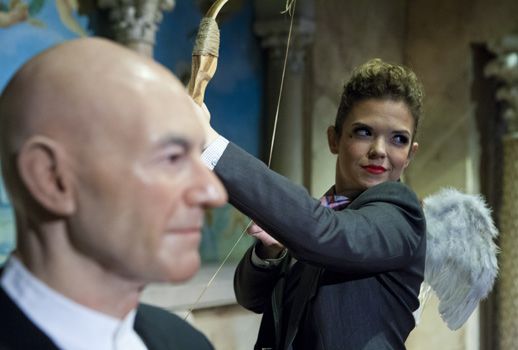

This is the third show done by On Site, founded in 2012 by director Eric Einhorn and dedicated to producing opera in non-traditional spaces. Rameau’s opera is based on the mythical sculptor of Ovid’s Metamorphoses (also the source for both Shaw’s play and My Fair Lady) who falls in love with a statue he has created, and Einhorn set his vision in a large space on the top floor of Mme Tussauds “peopled” by a number of the uncanny celebrity wax figures for which the museum is renowned. A tenor Pygmalion is first seen putting the finishing touches on his “Patrick Stewart,” as “Julia Roberts” and a vacantly-staring “Kim Kardashian” pose on the sides. Jennifer Peterson and her hard-working twelve-member period orchestra performed just to the right of the small playing area.
Not an “opera” per se, Rameau’s 45-minute masterpiece is instead an acte de ballet which premiered at the Paris Opéra in 1748. Although Pygmalion was only his second acte de ballet, the composer by then already had an oeuvre filled with other single-act works where dancing is as important as singing. Earlier full-length opéra-ballets like Les Indes Galantes and Les Fêtes d’Hébé consist of a prologue followed by three or four discrete, self-contained entrées (short operas). Another such composite work, Les Fêtes de l’Hymen et de l’Amour composed the year before Pygmalion, receives its US premiere this fall in Washington and New York by Opera Lafayette.
After its hero’s initial anguished lament “Fatal amour, cruel vainqueur,” the first half of Pygmalion proceeds with three dialogues between Pygmalion and his neglected lover Céphise, his vivified La Statue (unnamed in the opera but often called Galatea), and finally the god L’Amour who praises his great art in creating such a perfect work. Then a suite of Rameau’s endlessly inventive, justly celebrated dance music takes over with several gavottes followed by a loure, a passepied, a rigaudon, and a tambourin. Although Einhorn used some of this and subsequent dance music for pantomime, there was lovely dancing by Eloise DeLuca and Jordan Isadore, who was also the apt choreographer.
Controversially Einhorn’s production sought to invest the work with an extra layer of emotional complexity by having the sculptor experience a crisis and reject the Statue (whose first hesitant moments of life were cannily evoked) to return to the steadfast love of Céphise. This new denouement wasn’t entirely convincing particularly as it is contradicted by the text of Pygmalion’s final bravura air “Règne, Amour” where he gratefully thanks the god of love for animating his beloved statue.
As La Statue and the newly prominent Céphise, sopranos Camille Zamora and Emalie Savoy respectively revealed opulent voices occasionally reined in by the delicate music and smallish venue. As the frequently too impish L’Amour, Justine Aronson wielded a smaller, more pointed soprano that sometimes disappeared as the line dipped low. After a disastrous initial missed entry, the four-member chorus coped well enough with its few contributions while prancing perkily as required.
A veteran of many local early-music performances and a stint with Les Arts Florissants, Marc Molomot struggled with the stressful haut-contre tessitura of perhaps Rameau’s most demanding tenor role. While not the conventional image of a love-struck artist, he convincingly brought off Einhorn’s tricky conception of a man pining to be paired with his Stepford statue before realizing that he already had the love he longed for with Céphise whom he embraces in the final tableau. Molomot ended strongly with a brave rendition of “Règne, Amour” where he gratifyingly lightened his approach and nimbly negotiated the nearly impossible florid writing.
Against the odds, the New Vintage Baroque Orchestra, led from the harpsichord by Peterson, did a fine job with Rameau’s quirky quicksilver music which ideally calls for a band at least three times as large. The strings playing one to a part only sounded undernourished at moments, while the pairs of traverse flutes and oboes and a single bassoon reveled in the sensuous wind writing. The players did particular justice to one of the composer’s greatest overtures where many repeated figures wittily suggest the tapping of the sculptor’s chisel. The presence of a theorbo was puzzling; one rarely hears it used in Rameau performances and none of the three recordings I own of Pygmalion include one.
Of those, Gustav Leonhardt’s sublime 1980 Pygmalion, one of the indispensable Rameau recordings, is unfortunately out of print on CD but is available here:
In it, English tenor John Elwes struggles occasionally but his sculptor is so vivid that he overcomes any objections. Christie and his Les Arts Florissants brought their Pygmalion to Alice Tully Hall in 2011, an event enlivened by rapturous orchestral playing but dampened by an adenoidal leading man; happily the group’s 1991 recording stars the great American tenor Howard Crook as its superbly suave hero.
Over twenty years ago, one of the much-missed New York French baroque presentations by James Richman and Concert Royal included a fine staging of Pygmalion with Jeffrey Thomas; more recently the group has made a recording of the work (which I have not yet heard) with the talented young French tenor Mathias Vidal.
One of New York’s shockingly few local contributions to the worldwide commemoration marking the 250th anniversary of Rameau’s death, On Site’s Pygmalion performs thrice more this week (19-21 June) although in a new venue: the Chelsea showroom of Lifestyle-Trimco, a firm specializing in mannequins. Thursday’s show will feature a particularly intriguing experiment: the first-ever opera performance to transmit the English translation of the work’s text to its audience via Google Glass.
Photo: Pavol Antonov

























Comments